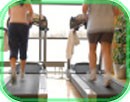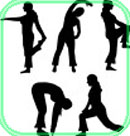|
Fitness Pyramid Getting in Shape by Climbing the Fitness Pyramid: Eighty-Five percent of Americans recognize that regular physical activity is important to good health, but only 40% lead active lives. "The big problem for most people is getting started," says Jeff Swiefel, M.A., an exercise physiologist and director of product development for NordicTrack in Chaska, Minnesota. "People know they will feel better if they exercise, but they're not sure how to fit it into their daily lives." AIM FOR THE TOP To help you lead a more active lifestyle, Zwiefel suggests "thinking of physical activity as a pyramid. You start with a basic level of activity -- walking, housework, yardwork and the like -- then you work your way upward through a variety of more challenging activities." Here is how you can climb the fitness pyramid: Level 1: Enjoy an active lifestyle:
By accumulating just 30 minutes of activity a day, you slow or stop the loss of function that comes with a sedentary lifestyle. You also increase your chances of living longer and improving your quality of life. Level 2: Do aerobic workouts:
You can exercise outdoors or in a gym using exercise equipment such as treadmills, stationary bikes and cross-country ski machines. "Your routine should be enjoyable and comfortable," Zwiefel says. "Increasing its intensity and duration gradually will prevent injuries." By challenging your cardiovascular system, you begin to actively fight the effects of aging and reduce your risk of heart disease and other degenerative conditions. Level 3: Start strength training:
A typical weight-lifting routine should include 8 to 12 exercises targeting all the major muscle groups. Do up to 3 sets of 8 to 12 repetitions of each exercise. Schedule at least two strength sessions a week with at least a day of rest in between. Level 4: Stretch to increase your flexibility:
A 5 to 10 minute routine should include all the major muscle groups. Do static stretches that ease you into position, then hold them for 15 to 30 seconds. "Flexibility training prepares our bodies for the tasks we perform throughout the day, such as lifting and reaching," Zwiefel says. "You dramatically reduce your risk of back problems when you increase your flexibility." Level 5 (the pinnacle): Compete for peak performance: Getting involved in competive recreational sports isn't essential for fitness, Zwiefel says, but it increases many people's enjoyment of an active lifestyle. That psychological benefit pays off physically. "If a sport challenges you and engages your mind, you're going to stick with it," Zwiefel says. "My advice for maintaining an active lifestyle is to find something you do well and enjoy, then have fun."
|
|
|||||||||||||
|
|||||||||||||
|
|
|||||||||||||
|
|||||||||||||




 Get
off the couch and get physically active. Your activity doesn't
have to be organized or continuous -- 10 minutes of walking
and 20 minutes of housework add up.
Get
off the couch and get physically active. Your activity doesn't
have to be organized or continuous -- 10 minutes of walking
and 20 minutes of housework add up. Now
that exercise is a part of your life, build regular workouts
into your routine. An effective aerobic program includes
at least 20 minutes of continuous, rhythmic activity three
or more times a week. Consider walking, jogging, cycling
or aerobic dancing. Exercise at an intensity that elevates
your heart rate into the target zone of 60% to 80% of your
maximum heart rate (Maximum heart rate = 220 - your age).
Now
that exercise is a part of your life, build regular workouts
into your routine. An effective aerobic program includes
at least 20 minutes of continuous, rhythmic activity three
or more times a week. Consider walking, jogging, cycling
or aerobic dancing. Exercise at an intensity that elevates
your heart rate into the target zone of 60% to 80% of your
maximum heart rate (Maximum heart rate = 220 - your age). Adding
weight training to your workout gives you the benefits you
can't get with aerobic exercise alone. It protects and builds
lean muscle mass; promotes healthier, stronger bones; and
raises your body's metabolism so you burn fat faster --
even while you're resting.
Adding
weight training to your workout gives you the benefits you
can't get with aerobic exercise alone. It protects and builds
lean muscle mass; promotes healthier, stronger bones; and
raises your body's metabolism so you burn fat faster --
even while you're resting. Inactive
muscles become shorter, and their range of motion gets more
limited. Reverse that process by doing gentle stretching
exercises before and after workouts and at other times during
the week.
Inactive
muscles become shorter, and their range of motion gets more
limited. Reverse that process by doing gentle stretching
exercises before and after workouts and at other times during
the week.